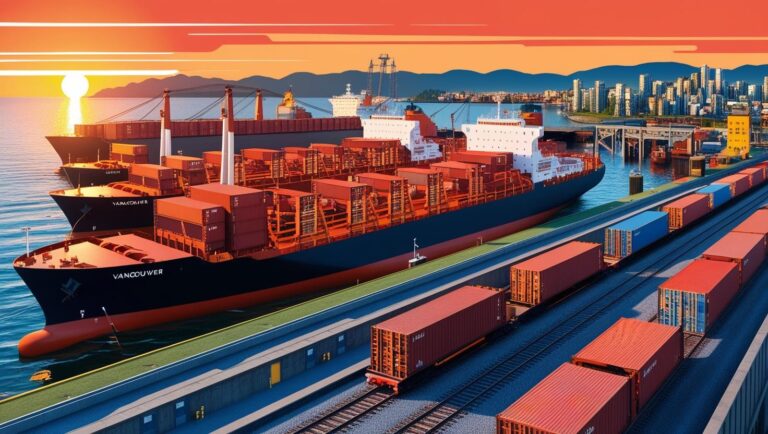Overview of the Industry
According to national and provincial trends, workforce availability, key projects, and assets in the region, Marine and Logistics has one of the strongest business cases for the region of North Vancouver. This is due to extensive supply chain needs for various local companies, as well as related logistics, port and warehousing technologies with multiple companies across the nation. North Vancouver benefits from extensive historical success in this sector, as well as from the presence of key anchor companies and a trained and available workforce. The concentration of marine transportation-related jobs in the region – from shipbuilding, support services to water transportation – is double the Canadian average. The Marine sector includes shipbuilding, marine technologies, port and logistics, and marine transportation. It is bolstered by national and international growth trends and existing assets within the region, with a focus on technology-driven services and niche light manufacturing. North Vancouver boasts unique opportunities for advanced manufacturing technologies within in marine transportation sphere (see section: Opportunities). The most significant asset related to marine transportation is the Port of Vancouver. Canada’s largest port processed 142.1 million tons of cargo in 2017 and is ranked 47th in the world by volume of container shipping. Working to strengthen the local sector supply chain and expanding the focus to niche products and services that support existing North Vancouver port activities provide significant growth and investment attraction opportunities overall.

Quick Takeaways
- Ship building has grown by 30% job since 2014, compared to 1% growth nationally.
- There is a strong technology base in North Vancouver that can translate into advanced port, warehousing and shipbuilding sectors.
- The National Shipbuilding Strategy is forecasted to contribute approximately $4.4 billion to Canadian GDP between 2012 and 2022, and support 5,500 jobs nationally.
- North Vancouver is strategically located along the Burrard Inlet with access points by rail and sea to AsiaPacific Gateway markets. The movement of goods and commodities along these access points plays a prominent role in regional and international trade.
- Shipbuilding is a key component of the marine cluster. It has received a significant boost from substantial contract wins by the Seaspan Group. These multi-billion dollar National Shipbuilding Strategy contracts helped the manufacturing output in the region grow to an impressive 8.6% in 2015.
Workforce Availability
- There is a deep talent pool in North Vancouver, which further strengthens the marine sector.
- Key occupations for the traditional ship building industry have an overall concentration of 5.7 relative to the nation, indicating an above average workforce availability.
- These occupations experienced an overall job increase of 7.5% between 2012 to 2017, especially for industrial painters/coaters, industrial electricians and structural metal and platework fabricators.
- The workforce in North Vancouver is further strengthened and supported by the Marine Campus of the British Columbia Institute of Technology (BCIT). The school offers marine industry accreditation in various onship and portside occupations.
Opportunities
- Marine technologies: The construction of both commercial and naval ships has spurn demand in sub-sectors such as electronic navigational devices, communication equipment, radar and sonar, marine robotics, sub-sea vehicles, imaging equipment, and marine application programming. Another principal driver of the wider logistics industry is investment in technology innovation. “Connected logistics” denotes the use of advanced IT solutions for the logistics industry, including IT services, software, and hardware. This includes the logistics Internet of Things, Big Data and predictive analytics, navigation, communication, and warehouse technology, trailer and container security, cargo optimization software, cloud computing, robotics, unmanned vehicles and augmented reality according to Industry Canada, First Research.
- Marine transportation: Key opportunities for growth in the sector are related to advanced manufacturing technologies such as increased automation, unmanned cranes, automated gates for entry and exit, and optical character reconvicting technology to track cargo movement, as well as continuous applications of data and logistics analysis tools and services.
- Shipbuilding and repair: The National Shipbuilding Strategy by the Government of Canada has resulted in significant investment in infrastructure, ship construction, and repair and maintenance (see section: Quick Takeaways).
- Supply chain opportunities: Seaspan’s supply chain consists of more than 500 suppliers of goods and services needed to fulfill its shipbuilding contracts. The successful fulfillment of the existing shipbuilding contracts requires enhanced access to local suppliers, which in turn creates opportunities to attract new companies who are able to meet the local sector supply needs. Specific niche opportunities may include further connected logistics and automation services and products. Advances in disruptive technology such as 3D printing put pressure on traditional suppliers in this sector and favour localized manufacturing.
SECTOR PLAYERS
- Seaspan ULC: Seaspan has been conducting marine transportation, shipyard and dry dock operations in North Vancouver for close to 50 years.
- Richardson: One of the key terminals in North Vancouver exporting nearly three million metric tons of grain and oilseeds each year to countries along the Pacific Rim.
- Neptune Bulk Terminals: A key terminal in North Vancouver which handles potash, coal, bulk, vegetable oils, fertilizers and agricultural products to be shipped to markets around the world.
- Fibreco: One of the largest wood biomass handling terminals in the world. They are currently enhancing their terminal to accommodate the export of agricultural products to Europe and Asia.
- Western Stevedoring: A diversified stevedoring, terminal, and logistics company with operations throughout B.C.
- Port of Vancouver: One of Canada’s largest and most diversified ports, working together with port terminals and tenants to ensure the safe, efficient, and reliable movement of goods and passengers.
Sources:
www.tpsgc-pwgsc.gc.ca/app-acq/amd-dp/mer-sea/sncn-nss/index-eng.html
www.bcit.ca/about/marine.shtml
http://www.firstresearch.com/



